Fort Snelling
|
Fort Snelling | |
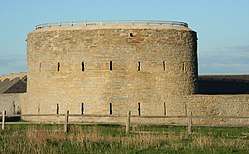 Fort Snelling's round tower | |
 | |
| Location | Hennepin County, Minnesota, U.S. |
|---|---|
| Nearest city | Just south of Minneapolis city limits and across Mississippi River from St. Paul at West 7th Street Bridge. |
| Coordinates | 44°53′34″N 93°10′50″W / 44.89278°N 93.18056°WCoordinates: 44°53′34″N 93°10′50″W / 44.89278°N 93.18056°W |
| Built | 1819 |
| Architect | Colonel Josiah Snelling |
| Website | http://www.historicfortsnelling.org |
| NRHP reference # | 66000401 |
| Significant dates | |
| Added to NRHP | 15 October 1966[1] |
| Designated NHL | 19 December 1960[2] |
Fort Snelling, originally known as Fort Saint Anthony, was a United States military fortification located at the confluence of the Minnesota and Mississippi rivers in Hennepin County, Minnesota. The Mississippi National River and Recreation Area, a National Park Service unit, includes historic Fort Snelling.
The fort is located in Fort Snelling Unorganized Territory in Hennepin County, Minnesota, named after the fortification. The Minnesota Historical Society now runs the fort, located atop a bluff along the river. The Minnesota Department of Natural Resources runs Fort Snelling State Park, protecting the land at the bottom of the bluff. Fort Snelling once encompassed both parcels.
The fort is designated as a National Historic Landmark and has been named a "national treasure" by the National Trust for Historic Preservation.[3]
History
Origins
In 1805, Lieutenant Zebulon Pike acquired Pike's Purchase from the Sioux Nation for the United States, comprising 100,000 acres (400 km²) of land in the area. Significant European-American settlement began in the late 1810s. Following the War of 1812, the United States Department of War built a chain of forts and installed Indian agents at them between Lake Michigan and the Missouri River. These forts primarily protected the northwestern territories from Canadian and British encroachment. The Army founded Fort Saint Anthony in 1819.
Colonel Josiah Snelling commanded the 5th Infantry Regiment (United States). Its soldiers constructed the original Fort Saint Anthony from 1820 to 1824. During construction, most soldiers lived at Camp Coldwater, which provided drinking water to the fort throughout the 19th century. The post surgeon began recording meteorological observations at Fort Saint Anthony in January 1820, beginning one of the longest near-continuous weather records in the country. Upon the fort's completion in 1825, the Army renamed it as Fort Snelling in honor of its commander and architect.
Frontier post

The soldiers at the northwestern frontier outposts tried to restrict commercial use of the rivers to United States citizens (after the War of 1812 the US banned British-Canadian traders from operating in the US), keep American Indian lands free of white settlement until permitted by treaties, enforce law and order, and protect legitimate travelers and traders. At Fort Snelling, the garrison also attempted to keep the peace among the Dakota people.[4]
Colonel Snelling suffered from chronic dysentery, and bouts of the illness made him susceptible to anger. Recalled to Washington, he left Fort Snelling in September 1827. Colonel Snelling died in summer 1828 from complications due to dysentery and a "brain fever".
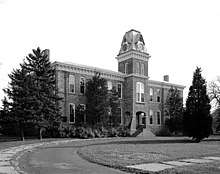
John Marsh, a native of Danvers, Massachusetts, came to the fort during the early 1820s. At the fort, he set up the first school in the Northwest Territory, to educate the children of the officers.
Marsh developed a good relationship with members of the local Dakota band. He compiled a dictionary for the Dakota language. He had been studying medicine at Harvard for two years before deciding to leave school without earning a degree. He used this opportunity to "read medicine" under the tutelage of the post physician, Dr. Purcell. The physician died before Marsh completed the two-year course, so he still had no medical degree.[5][lower-alpha 1]
In 1830 Fort Snelling was the birthplace of John Taylor Wood, who later became known as a lieutenant in the Confederate navy. He served on board the Merrimack at the Battle of Hampton Roads.[6]
Officer John Emerson purchased the slave Dred Scott in Saint Louis, Missouri, a slave state. He later worked and lived at Fort Snelling during much of the 1830s, having brought Dred and his wife Harriet Scott with him. Under the Missouri Compromise, slavery was prohibited in Minnesota Territory. When Emerson returned to Missouri with the Scotts, they sued for their freedom and that of their daughters, because they had been held illegally in a free territory. A longstanding precedent in freedom suits of "once free, always free" was overturned in this case. (The cases were combined under Dred Scott's name.) It was appealed to the United States Supreme court. In Dred Scott v. Sandford (1857), Chief Justice Taney ruled that the Missouri Compromise was unconstitutional and that African Americans had no standing under the constitution, so could not sue for freedom. The decision increased sectional tensions between the North and South.
Career Army officer and artist Seth Eastman had two tours at Fort Snelling, the second a lengthy one in the 1840s when he commanded the fort.[7][8] He completed many paintings and drawings of the Dakota and other Native American peoples while here, and helped record their customs and lives.[9] He was commissioned by Congress to illustrate the six-volume study of Indian Tribes of the United States by Henry Rowe Schoolcraft, which was published 1851-1857 with hundreds of his works.[10]
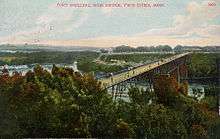
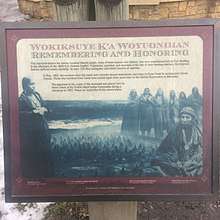
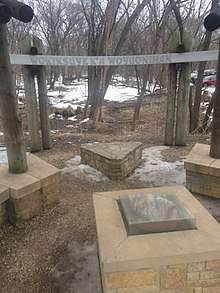
As the towns of Minneapolis and Saint Paul, Minnesota were developed in this area and increased in population, there was less need for a forward frontier military post in the region. The Army sold Fort Snelling to Franklin Steele, a friend of the sitting President, James Buchanan,[11] in 1858 for $90,000. (The deal included 8000 acres (32 km²) later annexed into south Minneapolis.)[12]
Civil War and afterwards
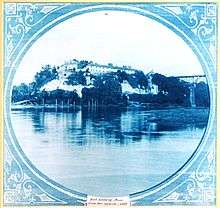
During the American Civil War, Franklin Steele leased Fort Snelling back to the War Department for use as an induction station. More than 24,000 recruits from Minnesota were trained here.[13] During the Dakota War of 1862, the Army used it as an internment camp, holding hundreds of Dakota women, children, and elders as captives on the river flats below the fort through the winter of 1862–63. Hundreds died there due to the harsh weather and disease outbreaks.[14] After the winter, the Dakota people interned at Fort Snelling were forced onto steamboats and taken to Crow Creek in Southeastern South Dakota; more community members were lost on the way. The survivors at Crow Creek were forced to move again three years later to the Santee Reservation in Nebraska. There now stands a memorial on the river flats outside of the Fort Snelling visitor center remembering and honoring those Dakota people that were lost as a result of the state's actions. [15] After the war, Steele leased the land around Fort Snelling to settlers, and Minneapolis began to expand into the fort's surroundings.[16]
The United States Army assigned a garrison to Fort Snelling. The fort dispatched forces to protect the interests of European-American pioneers on the frontier from the Dakota people, westward to the Rocky Mountains. Soldiers from Fort Snelling fought in the Indian Wars and the Spanish–American War of 1898.[4]
Through World War II, the War Department chose Fort Snelling as the location for the Military Intelligence Service Language School to teach the Japanese language to Army personnel. The War Department constructed scores of buildings for housing and teaching, and the school processed 300,000 soldiers.[4][12] The school was relocated to Monterey, California after the war, in June 1946.[17]
Second decommissioning
The War Department decommissioned Fort Snelling on 14 October 1946, and various federal agencies took parcels from the grounds of the old fort. The majority of the structures fell into disrepair. In 1960, the fort was listed as a National Historic Landmark, citing its importance as the first major military post in the region, and its later history in the development of the United States Army.[2][18]
Fort Snelling continued to serve as headquarters of United States Army Reserve 205th Infantry Brigade, which comprised three light infantry battalions and attached field artillery, cavalry, air defense artillery, combat engineers, and supporting logistics units throughout the Upper Midwest. The Defense Department deactivated this unit in 1994 as a part of force-structure eliminations. Over the decades, the Army interred many deceased Minnesotan soldiers and other members of the United States Armed Forces at Fort Snelling National Cemetery. Some military facilities continue to operate around old Fort Snelling.
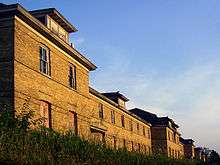
The Minnesota Historical Society has converted the area of the original walled fort into an educational establishment. The fort has been reconstructed to resemble its original appearance. It is staffed during the spring, summer and early fall with costumed personnel interpreting life at the early post. Although restoring and re-creating the original fort assures its survival as a historical artifact for the foreseeable future, many briefly used buildings of the fort have gradually fallen into serious disrepair and neglect. In May 2006, the National Trust for Historic Preservation added Upper Post of Fort Snelling to its list of "America's Most Endangered Places". Some restoration on historic Fort Snelling continues. Crews removed the flagpole from the iconic round tower and installed it in the ground, a change since its opening as a historic fort. Pending funding, the historic fort has planned a massive renovation project for the year 2020. In the process MHNS has cut the pay of summer interpreters by 12.5%.
The United States Navy named an amphibious warfare ship, the USS Fort Snelling (LSD-30), to honor the fort.
Notes
- ↑ Marsh eventually moved to Los Angeles, California, which was then part of Mexico. The provincial government certified him as a doctor after he showed them his undergraduate degree from Harvard (which was entirely written in Latin). For some time, he was considered the only doctor in California. He gradually amassed a fortune, and developed a large ranch. Much of it has been preserved as Marsh Creek State Park, near the present city of Brentwood, California.
See also
References
- ↑ National Park Service (2006-03-15). "National Register Information System". National Register of Historic Places. National Park Service.
- 1 2 "Fort Snelling". National Historic Landmark summary listing. National Park Service. Archived from the original on 2008-03-13. Retrieved 2007-10-03.
- ↑ Feshir, Riham (April 20, 2016). "Historic Fort Snelling named 'national treasure'". MPR News. Minnesota Public Radio. Retrieved April 20, 2016.
- 1 2 3 "Historic Fort Snelling: A Brief History of Fort Snelling". Minnesota Historical Society. Retrieved 2007-05-30.
- ↑ Colbruno, Michael "Lives of the Dead: Mountain View Cemetery in Oakland." December 12, 2009. Retrieved March 5, 2015..
- ↑ Winstead, 2009
- ↑ Patricia Condon Johnston, "Seth Eastman: The Soldier Artist", PBS, accessed 11 December 2008
- ↑ "Seth Eastman". United States Army Center of Military History. December 1, 2009. Retrieved June 16, 2010.
- ↑ "Seth Eastman", Library: History Topics, Minnesota Historical Society, 2011, accessed 3 February 2011
- ↑ "West Point, New York by Seth Eastman", with bio, US Senate, accessed 29 September 2009
- ↑ http://hennbios.tripod.com/steele.htm#
- 1 2 "Fort Snelling State Park Upper Bluff Reuse Study" (PDF). Minnesota Department of Natural Resources. November 1998. Archived from the original on 2008-03-07. ()
- ↑ "The Civil War". Historic Fort Snelling. Minnesota Historical Society. Retrieved July 6, 2013.
- ↑ "Forced Marches & Imprisonment". The U.S.-Dakota War of 1862. Minnesota Historical Society. Retrieved July 6, 2013.
- ↑ Referenced from the photo Wokiksuye K'a Woyuonihan on the right hand side of the page
- ↑ "Urban Connections – Minneapolis". USDA Forest Service. Retrieved 2007-05-29.
- ↑ Yamashita, Jeffrey T. "Fort Snelling" Densho Encyclopedia. Retrieved on July 3, 2014.
- ↑ Marilynn Larew (March 15, 1978). "National Register of Historic Places Inventory-Nomination: Fort Snelling" (PDF). National Park Service. Retrieved 2009-06-21. and Accompanying 29 images, including photos from late 1880s to 1977. (6.55 MB)
Other sources
- Winstead, Tim (2009). "John Taylor Wood: Man of Action, Man of Honor".
Wilmington, North Carolina: The Cape Fear Civil War Round Table. Retrieved Oct 7, 2013.
Further reading
- Anfinson, John O. (2003). River of History: A Historic Resources Study of the Mississippi National River and Recreation Area. St. Paul District, Corps of Engineers.
- DeCarlo, Peter. Fort Snelling at Bdote: A Brief History (Minnesota Historical Society Press, 2017). 96 pp.
External links
| Wikimedia Commons has media related to Fort Snelling. |
- Round Tower, Fort Snelling in MNopedia, the Minnesota Encyclopedia
- Three Score Years and Ten – Life-Long Memories of Fort Snelling, Minnesota, and other parts of the West, by Charlotte Ouisconsin Van Cleve. Published in 1888, from Project Gutenberg
- Fort Snelling National Cemetery, Department of Veterans Affairs Official webpage
- Minneapolis VA Medical Center, Department of Veterans Affairs Official webpage
- Minneapolis-St. Paul International Airport Official website
- NHL summary
- National Register of Historic Places Nomination Form – includes description and details on buildings
- Historic Fort Snelling page of the Mississippi National River and Recreation Area's website
